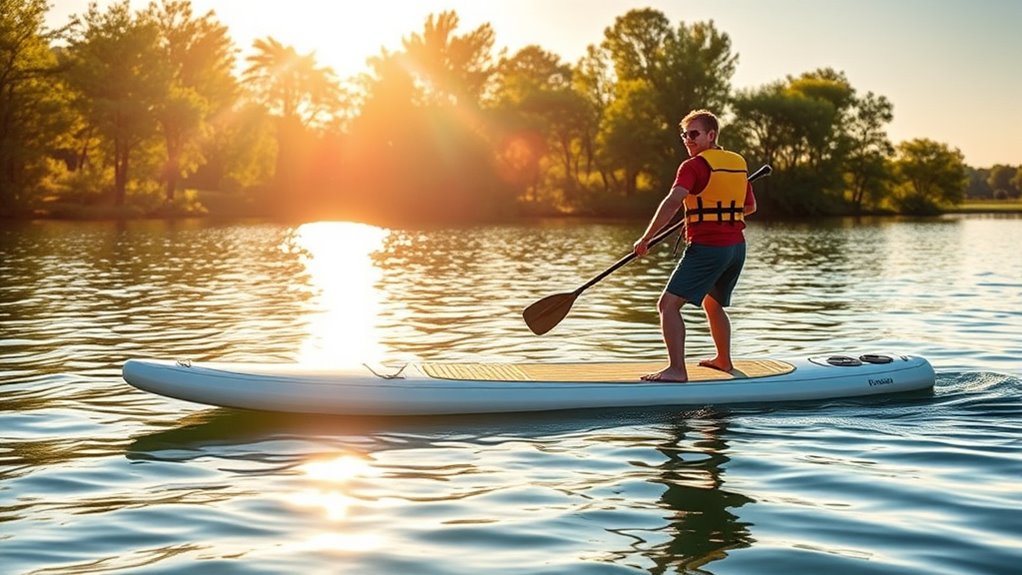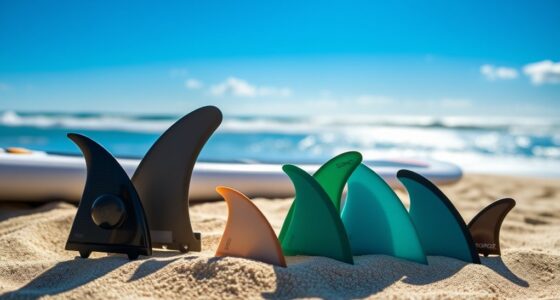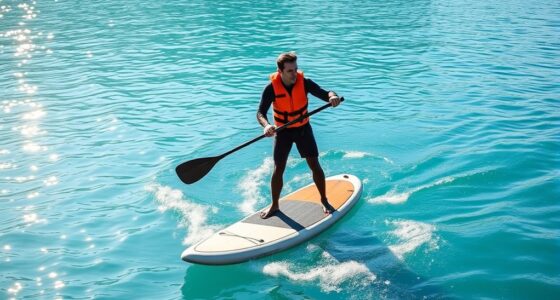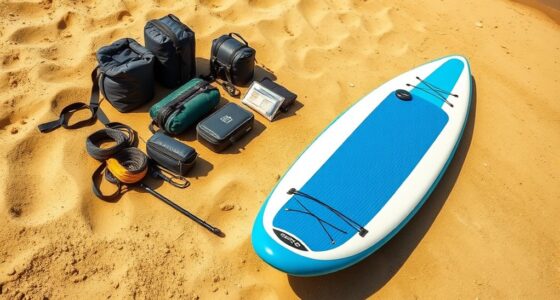Many SUP safety myths overstate dangers or ignore how proper precautions make paddling safe. Falling in isn’t inevitable, and with good instruction, gear maintenance, and awareness of weather, you can avoid most issues. Knowing rescue procedures and always preparing for the water helps you stay calm and confident. If you want to discover how to confidently debunk these myths and enjoy safer paddling, keep exploring what effective safety practices actually involve.
Key Takeaways
- Many SUP safety myths exaggerate risks; proper training and precautions greatly reduce accident likelihood.
- Falling in is not inevitable; with good technique and balance, beginners can minimize falls.
- Equipment failure is often due to poor maintenance, not inherent SUP dangers.
- Rescue procedures are simple and vital; knowing them prevents minor incidents from escalating.
- Awareness of weather, water conditions, and safety gear significantly enhances SUP safety and confidence.
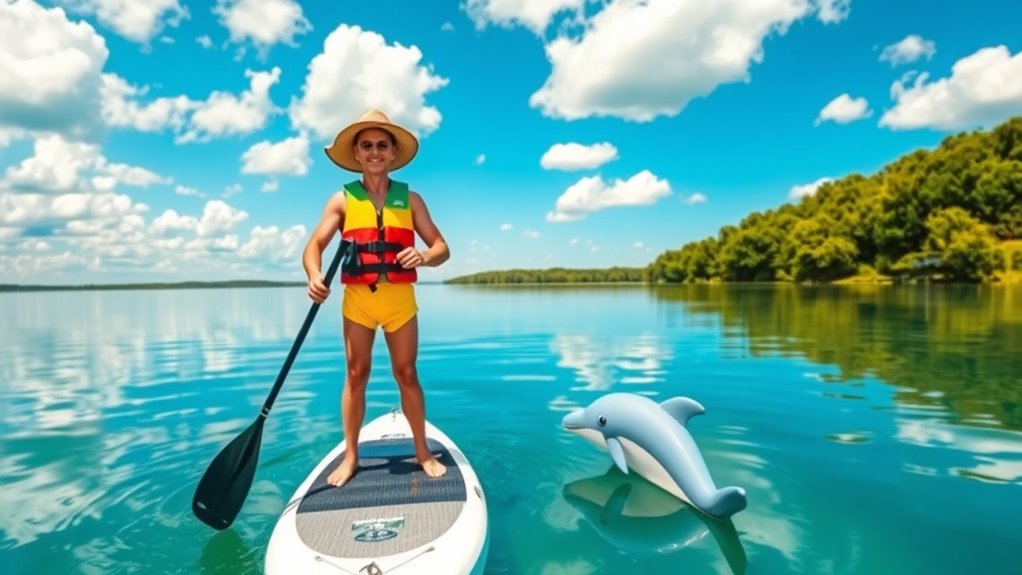
Have you ever wondered if stand-up paddleboarding (SUP) is truly as risky as some people say? Many misconceptions circulate around SUP safety, leading newcomers to believe it’s dangerous or unpredictable. The truth is, most accidents happen not because SUP itself is inherently unsafe but due to a lack of preparation or awareness. Knowing proper rescue procedures can make all the difference if you find yourself in trouble. Rescue procedures are straightforward but essential: staying calm, signaling for help if needed, and knowing how to assist a fellow paddler can prevent minor incidents from escalating. It’s also vital to have the right equipment and keep it in good condition. Equipment maintenance isn’t just about prolonging the life of your paddleboard and gear—it’s about safety. Regularly inspecting your paddle, leash, life vest, and board ensures there are no cracks, tears, or worn-out parts that could compromise your safety on the water. Neglecting maintenance might lead to equipment failure at a critical moment, increasing the risk of falls or drowning.
Many myths suggest that SUP is only safe for experienced swimmers or those with advanced skills. But the reality is, with proper instruction and safety precautions, beginners can enjoy paddling confidently. Wearing a life jacket and leash, for example, provides an extra layer of security, especially when tackling unfamiliar waters or strong currents. Additionally, understanding weather conditions and water currents can prevent accidents caused by sudden changes in the environment. Some believe that SUP is inherently dangerous because of the risk of falling in. While falling is possible, it’s not inevitable. Practicing balance, starting on calm waters, and using safety gear greatly reduce the risk of mishaps. It’s also a good idea to learn basic rescue procedures, so you’re prepared if someone falls or gets into trouble nearby. Proper equipment maintenance and awareness of environmental factors significantly enhance safety and confidence on the water.
Another common myth is that SUP is a solo activity with little risk of needing help. But in reality, paddlers should never underestimate the importance of being prepared and aware of rescue procedures. Having a buddy or informing someone about your plans can be lifesaving. Proper equipment maintenance, like ensuring your paddleboard and safety gear are in top shape, adds an extra layer of protection. When you combine awareness of rescue procedures with diligent equipment maintenance, you’ll find that SUP is much safer than it’s often made out to be. The key is being prepared, staying alert, and respecting the water. With these precautions, you can enjoy the sport with confidence, knowing you’ve minimized the risks.
Frequently Asked Questions
Can Beginners Safely SUP in Rough or Stormy Weather?
You should avoid SUP in rough or stormy weather, especially as a beginner. Weather considerations are vital because stormy conditions increase risks like strong currents and high winds, which can overwhelm your skills. Beginners face higher risks in such conditions, so it’s safer to wait for calm, stable weather. Always check the forecast and prioritize safety; rushing out in bad weather can lead to accidents or injuries.
Is Wearing a Life Jacket Mandatory for All SUP Activities?
You might wonder if wearing a life jacket is mandatory for all SUP activities. While safety gear regulations vary by location, wearing a life jacket is highly recommended and often legally required, especially for beginners or in open water. It considerably boosts your safety, providing buoyancy and peace of mind. Always check local laws and prioritize your safety gear requirements to ensure a secure and enjoyable paddling experience.
Are Inflatable SUPS Less Stable Than Hardboards?
Think of inflatable SUPs as the chameleons of the water—they might seem less stable, but that’s not always true. While hardboards often boast superior durability, inflatable SUPs now offer impressive inflatable stability, making them nearly as steady. Advances in technology mean you can choose based on your needs, knowing that inflatable boards are now more reliable than ever, even if hardboards still lead in durability.
Do I Need Special Skills to SUP in the Ocean?
You don’t need special skills to SUP in the ocean, but understanding basic stand-up paddleboarding techniques is essential. Always wear appropriate ocean safety equipment like a life jacket and leash, and stay aware of changing conditions. Start in calmer waters and gradually build your confidence. With proper preparation and awareness, you can enjoy ocean paddleboarding safely, even if you’re new to it.
How Often Should I Inspect My SUP for Safety?
You should perform safety checks on your SUP regularly, ideally before each use. Inspection frequency depends on how often you paddle and the conditions you encounter, but doing quick safety checks weekly is a good practice. Look for any cracks, delaminations, or damage to the board and verify the leash and fins are secure. Regular inspections help you catch issues early, keeping your paddling safe and enjoyable.
Conclusion
Now that you know the truth behind these common SUP safety myths, you can hit the water with confidence. Don’t let misconceptions hold you back from enjoying this fun and rewarding activity. Always prioritize proper safety measures, but remember that SUP is accessible and safe when you’re informed. So, get out there, stay cautious, and have a fantastic time paddling — the water’s waiting for you!

